Mattress companies love to tout the benefits of their unique technologies. More than anything, they like to talk about the benefits of foam vs. spring.
Ignore that noise.
While it's true that technology and construction can contribute to comfort, it's just a damn lie to say that either memory foam mattress or an innerspring mattress is better for everyone.
You need to look deeper than that.
This article explains the differences between the two most popular types of mattresses sold online and describes what types of sleepers benefit most from each – and why.
>> See My Favorite Innerspring Mattress >>
>> See My Favorite Memory Foam Mattress >>
Memory Foam
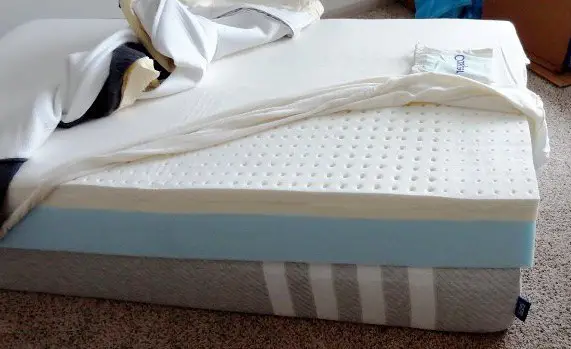
The very first type of memory foam, viscoelastic polyurethane foam, was introduced by NASA in the 1960s for use in aircraft seats. It later was used to support the Apollo astronauts when they visited the moon. A bit later, Tempurpedic introduced memory foam to the mattress industry, and the market for memory foam mattresses took off. For good reason, too.
Memory foam is an incredibly malleable and absorbent material that molds itself to just about any body shape. Memory foam cradles you firmly while you sleep, reducing the tendency to twist and turn. Memory foam also distributes weight evenly and reduces pressure points up to 80%.
This pliable nature explains why many people consider memory foam the most comfortable type of mattress.
Since the 1960s, the cost of manufacturing memory foam has dropped dramatically, leading to dozens of brands selling cheap foam mattresses – especially online. Today, there is a wide range of quality in foam mattresses. Most of them, you don't want.
That's one of the reasons we started this website – to help you sort through all of the noise online.
>> See My Favorite Memory Foam Mattress >>
Spring Mattresses
Spring mattresses remain the most popular type of mattress sold today, also for many good reasons. They are strong, durable, sleep cool and provide excellent support.
The three most popular types of spring-based mattresses are innerspring, individual coil and coil-on-coil designs.
Innerspring Mattresses
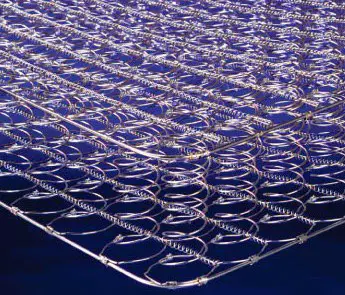
Innerspring mattresses contain a “box” of springs which are connected in a mesh. The coils are often connected to each other with metal strands, which makes innerspring mattresses super-strong and durable, but can also make them stiff or firm to sleep on, without the right upper layers on top.
Pocketed Coil Mattresses
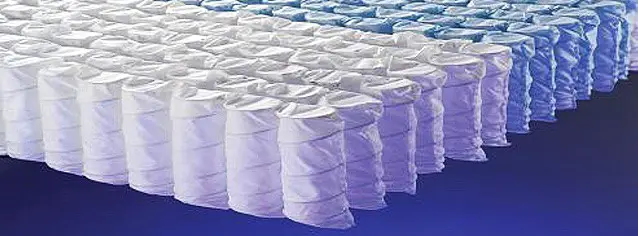
In individual, or ‘pocketed', coil spring mattresses, the springs are individually enclosed in cloth and separated from one another, which allows them to move independently. This design helps pocketed coil mattresses conform around body contours more easily, which is memory foam's greatest advantage.
Coil-On-Coil Mattresses
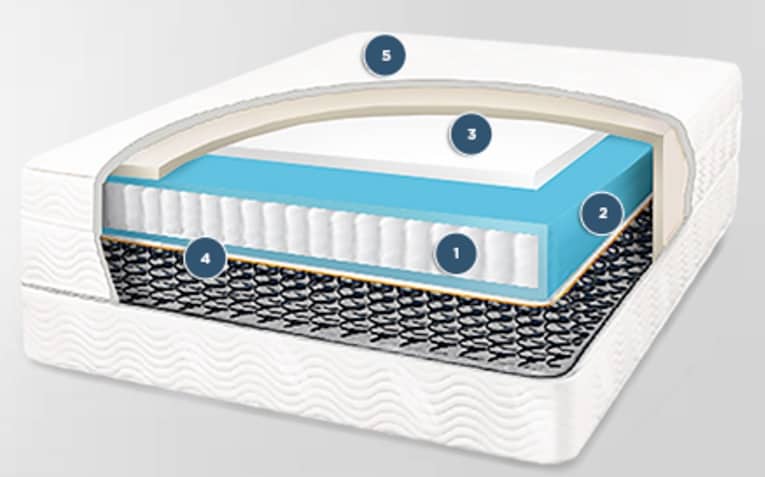
Coil-on-coil spring mattresses are exactly what they sound like – two or more layers of coils stacked on top of each other. A good example is the Saatva mattress, shown here.
Coil on coil designs minimize ‘bounce' and improve comfort by spreading body support over more coil systems than would be possible using a single-layered design.
In general, all spring mattresses provides outstanding support across the entire surface of the mattress and generate more ‘bounce' than memory foam.
>> See My Favorite Innerspring Mattress >>
Firmness Considerations
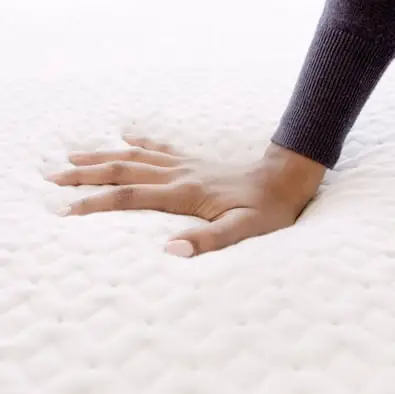
A mattress' firmness is measured using the ILD rating (Indentation Load Deflection). ILD is a measure of how much weight it takes to create an indentation of a certain depth. The higher the ILD rating, the firmer the mattress feels and the less it gives.
In general, memory foam mattresses are thought of as softer than a spring mattress. Memory foam firmness typically ranges between soft (ILD 10) to firm (ILD 120). But this isn't actually the case. Both types of mattresses are sold in all ILD ratings, from extra-soft to extra-firm.
One of the myths about memory foam mattresses is that foam density determines the softness or firmness of the mattress. The truth is that a high-density memory foam mattress can be soft or firm.
A spring mattress’ firmness is determined primarily by the coil gauge used in the springs. The lower the gauge, the thicker and stiffer the wires in the coils. So, lower-gauge coils create firmer mattresses.
Back Pain Sufferer?
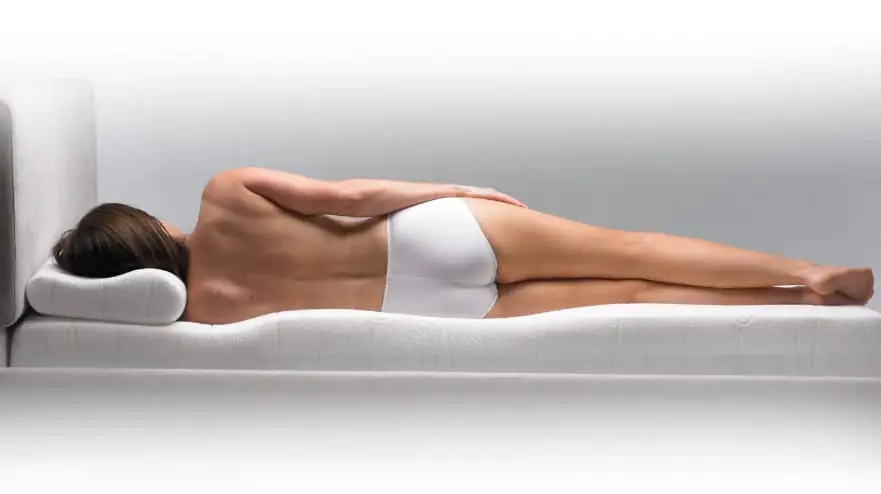
One of the myths about spring mattresses is that they are better for people suffering from back pain. That's not entirely accurate.
Unless it is topped with the right kind of foam layers, a firm spring mattress will not give much at all, meaning your body will rest all night on pressure points like your shoulders and hips. This can cause your back to spend all evening out of alignment.
Contrary to what most people think, a firm memory foam mattress can actually be a great solution for people with lower back pain. This is because memory foam has an open-cell structure that absorbs shock and relieves pressure very well, regardless of firmness. Even a very firm foam mattress will give some, because body heat will always makes it supple and mold to your body’s shape. The same cannot be said about extra-firm spring mattresses.
If you are a back pain sufferer, don't listen to the myths. What matters most is picking a mattress that supports you correctly, given your body weight and sleeping style. Here are a few great choices of mattresses for people who suffer from back pain.
>> See My Favorite Mattress for Back Pain >>
Temperature Sensitivity
Memory foam mattresses often suffer from heat issues, because the petroleum-based materials used to make memory foam absorb and reflect heat.
In general, a spring mattress sleeps cooler and remains unaffected by the sleeper’s body temperature.
They are adequately ventilated. However, spring mattresses that are topped with layers of foam and fiber for added comfort has received complaints of sleeping hot as with memory foam. Between 5% and 10% of users complain about heat issues.
Comfort and Support
Memory foam is a temperature-sensitive material that conforms and molds around the sleeper’s body as it warms. In cooler temperatures, the mattress is firm. When warmed by body temperature, the material becomes softer and more pliable. This basic property makes memory foam mattresses extremely comfortable for most people, overall.
Side-sleepers and people who tend to stay in the same position all night may prefer a memory foam mattress over a spring mattress, because memory foam is so pliable and resilient. It literally cradles you while you sleep – which means your body doesn't have to work to maintain your position.
>> See My Top Mattress Pick for Side Sleepers >>
That said, when sleeping on a high density foam mattress, you may get a “sinking” feeling as the temperature increases. About 12% of memory foam mattress owners complain about this issue. The lower the density, the less of a sinking issue.
Another comfort benefit of memory foam is that it prevents motion transfer from one side of the bed to the other. So, memory foam is a great choice for couples where one partner may move around at night, while the other is a light sleeper.
People who move around a lot at night will likely prefer a spring mattress over a memory foam mattress, because it is far easier to change positions on a spring bed. On the other hand, spring coils can provide uneven support, which can create pain for people who do not move around a lot at night.
Spring mattresses are usually not the best solution for a side sleepers, not just because of their general firm nature, but also because it's difficult for a spring mattress to provide proper spine alignment, which can lead to back ache and soreness. Of course, many spring mattresses today are covered in layers of foam which can reduce this issue greatly.
Smell is another consideration. Spring mattresses don't emit chemical odors like many memory foam mattresses do.
Durability
In general, most memory foam mattresses are not as physically durable as a spring mattress, although they may serve you longer.
All types of memory foam become softer and loses resiliency with age, so permanent body impressions can develop over time. Sometimes, depressions form within months after purchase, especially for overweight people.
As a result, most memory foam mattresses tend to last 4 to 10 years, depending on the quality of the foam and the construction of the mattress.
When compared with memory foam, a spring mattress is stronger and should last longer – if it were not for one very common issue: sagging.
Body impressions, “sink holes,” and “peaks and valleys” in spring mattresses often develop over time. In fact, about 25% of spring mattress owners complain of sagging.
On average, a spring mattress will need to be replaced every 3-10 years.
That said, quality matters a LOT with spring mattresses.
If you purchase a high-quality innerspring mattress like the Saatva, it could last as long as 15-20 years.
Hopefully, this article has helped you sort through the hype to better understand which type of mattress is right for you and your sleeping style.
If you have any questions, please post them below.
Learn More
>> See All Online Mattresses Compared Side-By-Side >>
Affiliate Disclosure
Affiliate Disclosure: I may earn a small commission (at no cost to you) if you purchase a mattress after clicking a referral link or using a coupon code on this site. That said, all content and opinions on this site are my own and are NOT affected by these payments.
This site participates in the Amazon Services LLC Associates Program, an affiliate advertising program designed to provide a means for sites to earn advertising fees by advertising and linking to Amazon.com.
*Amazon and the Amazon logo are trademarks of Amazon.com, Inc, or its affiliates.


